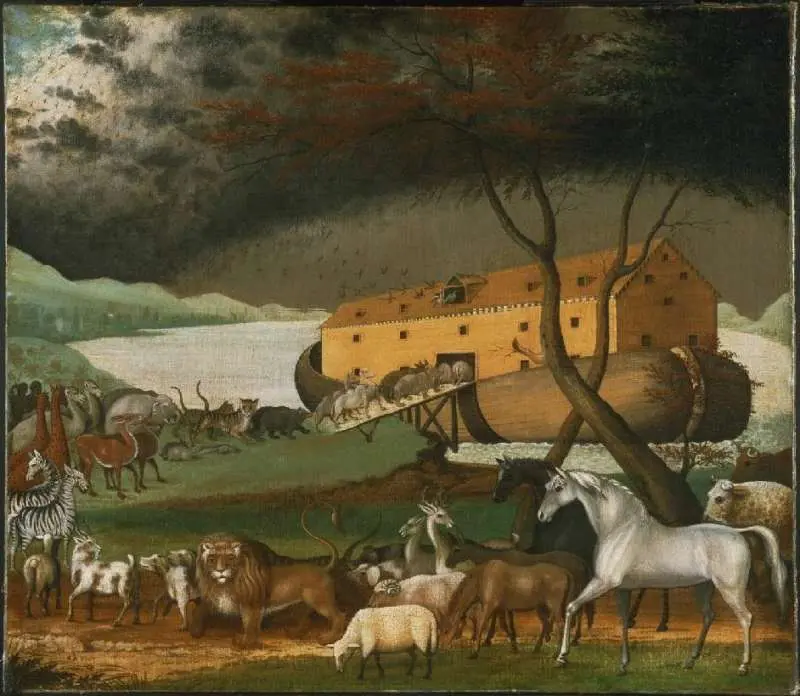The biblical text uses the word window twice in the account of the ark, each time using different words. This suggests to me that Noah built two different styles of windows in the ark.
First, the instructions God gave Noah specify a window as an overhead light source:
A light/ window/ opening/ noon [tsôhar] you shall make for the ark, and to a cubit you shall finish it upward/ above; and the door of the ark shalt thou set in the side of it; with lower, second, and third stories shalt thou make it. Genesis 6:16
The second word is identified as a window that Noah designed.
And it came to pass at the end of forty days, that Noah opened the window [challôn] of the ark which he had made/ appointed. Genesis 8:6
The text uses two different words because there are two different windows.
The first window is an overhead source of light, the word is the common term for “noon,” the point at which the sun is directly overhead. Notice also that the location of this skylight is said to be “above,” in contrast to the door “in the side” of the ark. This seems to point to an opening with some sort of transparent covering so that light would be admitted.
The first word is the Hebrew tsôhar צֹהַר, which occurs 24 times in the Old Testament. In every other occurrence it has the sense of midday. For that reason, we should allow it to mean the same thing in the account of the Ark.
The word in chapter eight is challôn חַלּוֹן, which occurs 31 times in the Old Testament. This word always seems to refer to an opening in the side of a structure out of which one could observe events outside.
This is the word used of the window out of which the king of the Philistines observes Isaac “sporting” with Rebekah his wife (Gen. 26:8). In the case of Rahab and the two spies it is a window in the side of the wall (Josh. 2:15). Other references repeat this sense of something in the sidewalls of a structure out which observations could be made (Jdg. 5:28; 1 Sam. 19:12; 2 Sam. 6:16; 2 Kings 9:30). Time after time challôn is an opening for observation and for admitting air for ventilation.
So what might this window have been like in the ark Noah built? It may have been a small water-tight porthole that Noah needed to open to release the birds. But in my opinion, more likely it was a ventilation opening that was under the eaves of the ark, but possibly protected from running awash by scuppers.







Very interesting! I’ve never seen that before. Thanks! William
Thanks William.
One might ask, “What difference does it make?”
It simply shows that the details as given demonstrate that this is a real account of a real event. It shows that the design of the Ark was real – and it was in fact a viable sea-worthy vessel for preseving life.
Likewise, the Salvation of God is real – and it is in fact a real means to give us light and life in the midst of a present evil world of darkness and death.
You have read a different Bible than I have!
There is no mention of a second window, period. A window in the side of the ark could not be sealed if it was meant to be opened. The ark was sealed within and without with pitch to make sure it was water proof. As a symbol of the sealing of the believer by the Holy Spirit would mean that there is one way in (though Christ) and one way out, going up. There are not two ways to reach heaven.
So sorry John, that you feel my Bible is different from yours. But if you will look in your very own Bible you will see that there are in fact two different words that are used “Window” in the Flood account. The first is found in chapter six:
Notice that this window is described as “ABOVE” – in contrast to the door, which is in the “SIDE.” Is that what is in your Bible?
The Hebrew word for this window is TSOHAR – which is also the word for “noon” – or light which is directly overhead. Thus, it means an over-head opening, or skylight.
There is a second usage of the English word “Window” – found in chapter eight:
Notice that this is described as a window which Noah had made – through which he released and then retreived the dove. Is this what you read in your Bible John?
The Hebrew word for this window is different, with a different meaning – it is CHALLON – and it ALWAYS refers to a window in the SIDE of a structure (a building, a fortress, or in this case, an Ocean Vessel – the Ark of Noah).
We are reading the same Bible – but I am also looking at the Hebrew words that were used, and I am deriving my understanding of the meanings of those words on the basis of how they are used in the rest of Scripture.
There is only ONE REVELATION from God in the Bible – but that Revelation about the Flood and the Ark was given in Hebrew – and the Bible is OK with us learning to understand the meaning of Hebrew words (Matt. 1:23; John 1:41).
We are reading the same Bible.
Thanks for your question. I hope this answer helps you to see what is in the same Bible that both you and I are reading together. Peace – Jim Brenneman